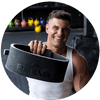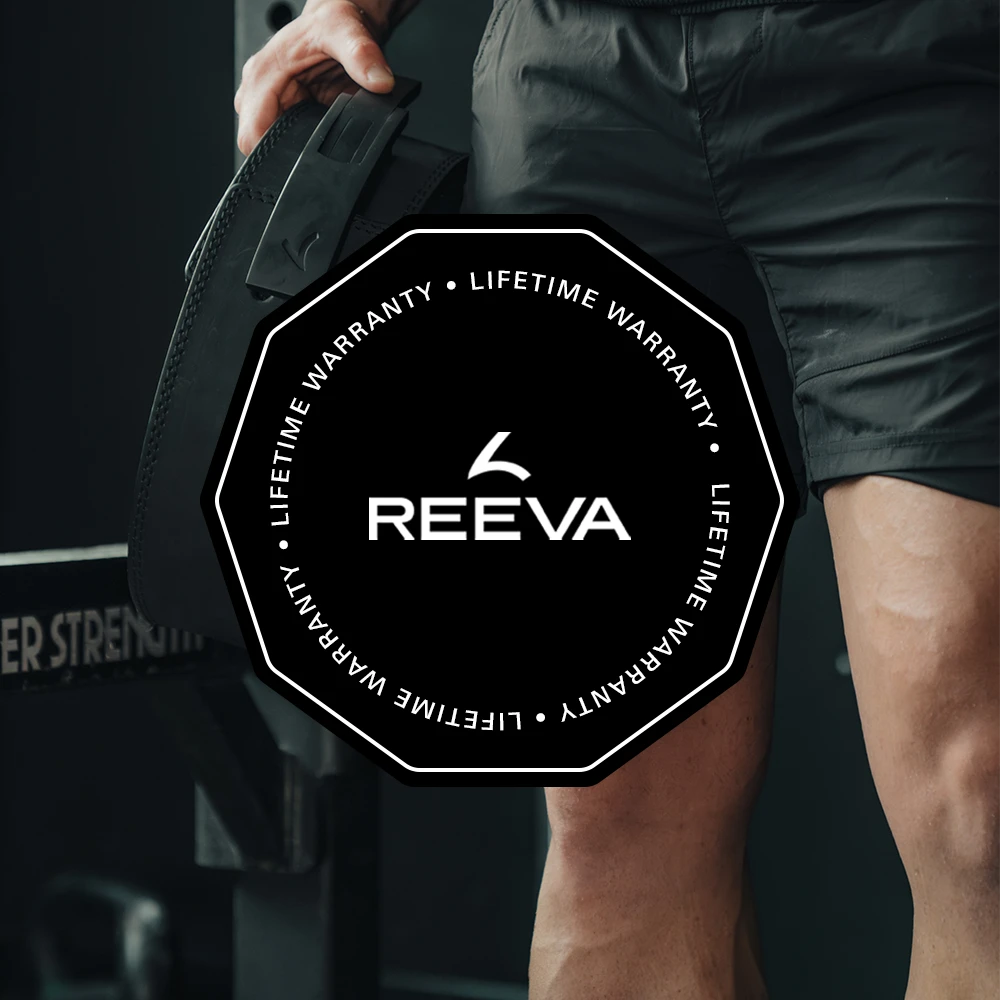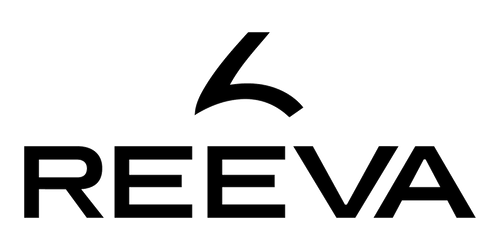What customers say about this product
Ceinture Lombaire Musculation
✓ Fabriqué à partir 100 % de matériaux authentiques
✓ Très durable et court temps de rodage
✓ Vie garantie sur cette ceinture de levage
En vedette sur ↓

Découvrez notre dernière innovation: la nouvelle ceinture de levage EVA Foam avec un système de libération rapide. La courroie est spécialement conçue pour l'haltérophilie et l'entraînement fonctionnel et offre un support équilibré dans le dos sans restreindre le mouvement.
Minimisez le risque, maximisez vos performances.

"My secret weapon for unlocking new levels of strength"
~ Rob Lipsett, Athlete & Entrepeneur
-
En termes simples, ces ceintures moins chères qui inondent le marché sont produites en masse en Chine à partir de matériaux bon marché. Ils sont fabriqués à partir de cuir PU et rembourrés d’un rembourrage en carton.
Au fil du temps, l’humidité s’infiltrera et décomposera le carton. Il en résulte une courroie de levage qui n’offre pas un soutien adéquat et, par conséquent, perd sa fonction. Cela peut ressembler à une véritable courroie de levage, mais croyez-nous, elles ne dureront pas.
Les courroies de levage Reeva sont fabriquées avec précision par des artisans qualifiés. Nous utilisons les meilleures peaux de buffle provenant de tanneries exclusives, garantissant une qualité et une longévité inégalées.
De plus, nos boucles en acier inoxydable renforcées sur mesure sont forgées par des forgerons locaux. Cela signifie que nos boucles sont incroyablement robustes et pratiquement indestructibles.
Nous parlons d’une qualité de premier ordre qui garantit une utilisation à vie. Êtes-vous prêt à investir un peu plus pour un produit qui non seulement surpasse ses concurrents, mais qui leur durera également un kilomètre ?
-
Nous croyons vraiment en la qualité de nos produits. C’est pourquoi nous offrons une garantie à vie sur cette courroie de levage. Lorsque votre article se casse en raison d’une fabrication défectueuse, nous offrons un remplacement gratuit.
-
• 100 % Fabriqué à la main dans notre propre usine
• Fabriqué avec le fil synthétique le plus fort en usage aujourd'hui
• Résistant à la corrosion et aux contraintes jusqu'à 9.384ps
• Trous espacés avec précision, pour un confort et un soutien optimaux
• Faisceau hydraulique pressé Logo réfléchissant
-
Quels sont les frais de livraison vers la France ?
Nous offrons la livraison gratuite à partir d'une valeur de commande de 100 €. L'expédition normale (commandes inférieures à 100 €) vers la France coûte 9,95 €.Comment ma commande sera-t-elle expédiée ?
Votre commande en France sera livrée avec DPD. Vous recevrez un lien de suivi et de traçabilité lorsque la commande quittera notre entrepôt.Combien de temps faudra-t-il avant de recevoir ma commande ?
Votre commande en France sera livrée en 3 à 5 jours ouvrés. -
Puis-je retourner ma commande si elle ne me convient pas ?
Oui, nous acceptons volontiers les retours et offrons un remboursement complet.Que dois-je faire si mon produit est endommagé ?
Veuillez contacter notre service d'assistance ! Lorsque vous êtes connecté à votre compte, le système de ticket d'assistance s'affiche dans la partie inférieure de votre écran.Pour l'instant, seuls les utilisateurs connectés peuvent utiliser ce système.
Les avantages d’une ceinture de levage pour votre entraînement 👇

Lifetime warranty
When investing in high-quality fitness equipment, it's essential to have confidence in the product's durability and longevity. Our products are specifically created to perform and outlast your most grueling training session. When you purchase gear from us, it’s backed by the Reeva promise. We stand behind our weightlifting equipment and accessories and we’re confident you’ll love our premium grade products.
On the off chance that you experience a manufacturing defect on any item (such as broken stitching or other damage upon arrival), you can return it for a complete replacement for the lifetime of owning your belt.
Frequently Asked Questions about Lifting Belts
-
A lifting belt provides support to your lower back and core muscles during heavy lifting exercises. It helps to stabilize your spine and reduce the risk of injury by increasing intra-abdominal pressure. This can improve your overall lifting performance by allowing you to lift heavier weights with better form.
Remember, a lifting belt isn't a magic item. It's important to use it with proper technique and training for best results. Using a lifting belt in your workouts can make you stronger and help prevent injuries. It's a good addition to your routine.
-
A lifting belt can help with strength training, but it's not essential for everyone. If you are a beginner or are not lifting extremely heavy weights, you may not need to use a lifting belt.
Before using a belt for support, it is important to build core strength and learn proper lifting technique. This will help create a strong foundation. Using a lifting belt too often can make your core muscles weaker. This is because they might rely too much on the support the belt provides instead of getting stronger by themselves.
Ultimately, you should base the decision to use a lifting belt on your individual needs and goals. If you're not sure if you need a lifting belt, ask a fitness professional for advice.
-
It is best to wear a lifting belt for heavy lifting exercises like squats, deadlifts, and overhead presses for safety. The lifting belt gives extra support and stability to your core, which is helpful when lifting heavy weights. However, it is important to remember that a lifting belt is not a substitute for proper form and technique. You should use it in conjunction with a solid foundation of core strength and good lifting mechanics.
Some lifters also choose to wear a belt during max effort lifts or when they are attempting new personal records. This extra support can help reduce the risk of injury and provide added confidence during challenging lifts.
Ultimately, you should base the decision to wear a lifting belt on your individual goals and comfort level. If you are unsure, start by using the belt into your training gradually and see how it feels. Remember, listening to your body and prioritizing safety should always come first in your fitness journey.
-
When picking a lever lifting belt, it's crucial to know the distinctions between a lever belt and a standard prong belt. A lever belt has a lever mechanism for adjusting tightness, while a regular prong belt uses a buckle. Knowing these distinctions can help you make the right choice for your lifting needs. Considering your preferences and lifting style is essential when deciding between the two types of belts.
A lever belt is easier to adjust and secure in place with a lever mechanism for precise adjustments. This can be beneficial for lifters who prefer a quick and secure fit without the hassle of adjusting prongs.
Some weightlifters may find it harder to put on and take off a lever belt compared to a regular prong belt. Additionally, lever belts tend to be more expensive than prong belts, so cost may be a factor to consider.
-
Use this text block to discuss some commonly asked questions like shipping and returns, sizing, warranties, or product and company details.
-
Belts can help increase squat weight, but the amount added depends on the person's strength and lifting skills. Wearing a belt can help people lift heavier weights more comfortably, possibly increasing their squat by 10-20%. In the end, Lifting Belts do not help you lift more weight, but they support your core during heavy lifts.
It's always best to focus on building strength and proper technique first, rather than relying solely on a belt to boost your squat numbers. Remember, consistency and dedication to your training will ultimately lead to progress and improvement in your squat performance.
-
Using a belt while lifting heavy weights can help stabilize the spine, reduce injury risk, and increase pressure in the abdomen. Belts can also provide a tactile cue for bracing your core, helping you maintain proper form throughout the lift. Some weightlifters feel more confident and mentally strong when wearing a belt, which can help them lift heavier weights.
However, there are also some cons to consider when lifting with a belt. Using a belt too frequently can weaken your core muscles over time.
They become dependent on the belt for support instead of developing their strength independently. This can ultimately hinder your overall strength and stability in the long run. Using a belt in training should be an addition, not a replacement for good technique and strong core muscles.
Decide whether to use a belt based on your goals, experience, and comfort level when lifting weights. Talk to a coach or trainer to see if you should use a belt when lifting weights. Remember, proper technique, consistency, and progressive overload are key factors in improving your strength and performance in the gym.
-
Choosing between a 10mm or 13mm belt depends on what feels best for you. It's all about personal preference.
The 13mm belt is typically thicker and may provide more support, while the 10mm belt is slightly lighter and more flexible. Some weightlifters like the 13mm belt for heavy lifts because it provides more stability. Others prefer the 10mm belt for deadlifts and squats because it is less restrictive.
Try both belt sizes to see which one helps you keep good form and feel secure during lifts. Remember, the belt should enhance your performance, not hinder it. Choose the belt that best aligns with your lifting goals and technique, and always prioritize safety and proper form above all else. With the right belt and proper technique, you can take your lifting to the next level and reach your strength goals effectively.
















